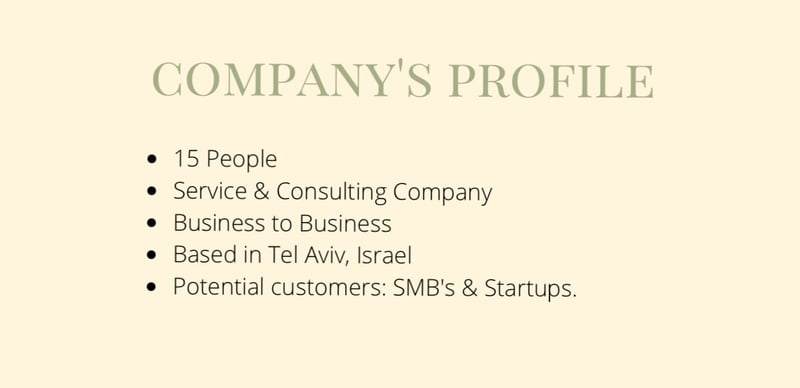
A few months ago, I got a call from the CEO of a service boutique company -- he was nervous that his company did not have any sales procedures in place. Because of this, they had a difficult time making sales since they launched their new service.
I decided to meet with the CEO and some of the employees in their Tel Aviv office. They took the meeting very seriously and began devoting the entire company TO BRING IN SALES.
“Now we need to FOCUS on SALES,” said the CEO.

From the moment our teams met, we recognized the amount of work we had to do.
-
The company did not have sales procedures or a sales funnel in place.
-
The roles of the employees were unclear — everyone was doing everything. No one had clear responsibilities as the CEO and COO were allocating tasks regardless of their context.
-
In the beginning, the company had no CRM. They added and tried to manage a CRM but didn’t know how to implement their strategy with it — this happens a lot.
-
All company employees, including management, were unable to differentiate between Marketing, Pre-sales, Sales, Customer Success, and Finance. Additionally, they didn’t use those terms nor were they even conscious of them.
It is important to note that we, at Scaleops, brought our terms and definitions from the tech industry. Often when we work with service companies we train them to work like a start-up.
The First Week of Establishing a Robust Sales Operations
I always like to start with the simple question of: Describe your sales process from the moment you get a lead, and describe what lead sources you use.
The CEO and COO started to tell me the whole process concerning how they generate leads and who manages each step. In their case, everyone was managing everything, which meant they couldn’t concentrate on any specific function until they realized that potential deals kept falling between the cracks.
We decided to work together and make this their main goal. We defined the KPI’s and weekly targets we wish to achieve, and I started with building their sales operations, and sales funnel as follows:
The First Step – Sales Operations Audit
This Step Includes Three Sub-Steps:
First, we conducted a full audit of all the companies existing sales processes, software (CRM & Sales tools), policies and guidelines.
Second, we interviewed the people who were part of the sales cycle. This included those in Marketing, Pre-sales, Product, Sales, Management, Legal, Finance, Post-Sales, etc.
Through this, we learned about the companies complete sales process in-depth, from end to end. We also better understood the business and kinds of services it offered. This took approximately one week to complete, and I insisted on having it done before we started to draw a new process.
Third, we researched existing sales strategies.
By this sub-stage, we had a great deal of in-house information from different teams about their work with clients and in the sales cycle itself. Now, it was time to ask strategic questions and have discussions with the management about their intended target audience, the existing state of sales and tools, and materials the company was using/wished to start using.
Once the audit was done, we were ready to go!
The Second Step – Identifying Problems and Crafting Solutions
After a full audit, we began to identify problems related to the sales process. In this case, I decided to explore the full process from lead to cash. The following is a small brief of what we did:
Marketing
The company had no marketing strategy, and most of their leads came through the CEO’s network.
The CEO was getting phone calls or WhatsApp messages, and sometimes it wasn’t well communicated with other teams to proceed with the sales process. So, we decided to:
-
Start using HubSpot to keep track of their leads—representing them with a simple lead scoring.
-
Define a business development role and assign it to an employee.
-
Talk with a Marketing strategist to build a proper marketing funnel for the company. In the beginning, we had to set a temporary marketing plan which included social media exposure, content, blogs, and newsletters to start “running the machine” as well as provide value to the company’s followers and those who read the content.
Business/Sales Development
We decided to create and define this role in order to have someone develop new relationships with contacts and speak with anyone who reached out. This role is quite critical for many companies as someone needs to see if potential clients will be a good fit. Additionally, they need to asses wether or not the company can provide value and help to the client and "get the job done.”
Pre-Sales
Before we managed to define the technical team as a Pre-Sales team, we realized that they were a critical function in the sales cycle. They made the initial calls to the prospects, filling out a questionnaire with necessary information.
BUT— Was their job only to fill out a questionnaire and follow questions like a robot? The answer is no. This technical team had to be defined as Pre-Sales as they had a lot of impact on the company’s potential clients. They listen to their problems and provide them with value starting from the very first call. They have to be experts, consultants and KNOW HOW TO SELL. That’s why we ultimately decided to call them the Pre-Sales team. :)
I sat in on a few calls with members of the Pre-Sales team as they spoke with potential customers. This way, I could audit the team’s performance and show them how to leverage their technical knowledge to be both sales and technological leaders.
Sales
Until this stage, we had the CEO and COO doing many of tasks that they could have been delegating to other teams. Outside of the commercial side of the business, where they needed to be involved, I decided to reduce the CEO and COO’s responsibilities as much as possible.
We also working to optimize the company’s sales stages—automating them as much as possible in order to reach a simple and effective process at the end. This step effected many teams (such as legal, finance and post-sales) and helped solve their problems. I’m happy to tell you more about that in my next articles.
The Third Step — A CRM with Sales Processes and Strategy
We soon gained an understanding of how the sales process and strategy should have looked, and were able to implement it in the CRM.
We chose HubSpot, using the free tool to start. It is always essential to choose the right CRM, which fits both the company’s needs, size and budget.
It took us one month to implement a process that was as straightforward as possible. We made sure to cover the complete process from the moment a company gets a lead, until the moment a deal (hopefully a SUCCESSFUL deal) is closed.
The Fourth Step - Ensure Goals Are Met
During this step, we went back to the KPIs in order to monitor the metrics and create more KPI’s to track the sales metrics.
We designed dashboards and reports in order to represent sales KPIs, for example:
-
Quarterly sales deals vs. targets
-
Sales Qualified Leads conversion rate
-
Proposal stage conversion rate
-
Pre-Sales conversion rate and monthly calls growth
-
And more!
The Fifth Step - Steer Sales and Train the Team
Training was a constant and integral part of all stages. However, I believe that companies should have enough knowledge to lead the right sales processes and manage their operations on their own. Therefore, we always do a handoff before we finish a project. This way, we can make sure everyone is in alignment and aware of their responsibility and how it correlates to the full sales process.
We led different training sessions, such as:
-
How to manage daily sales operations
-
How to handle "Go to Market – weekly sales meetings"
-
How to build a sales forecasting model
-
How to improve sales and pre-sales calls to fit the current sales process
-
And more!
What Happened Next?
After we worked with them, the company managed to close a few deals in a short period of time and happy customers gave them compliments about their sales process. Can you imagine how potential customers felt about how organized everything was internally?
That was even a surprise for me. :)

For companies who are still wondering...
The sales field contains both content and process. Three things are vital to succeed with selling—talented salespeople, an excellent pitch, and a proper sales process.
If you find the sales process in your company challenging, book a free evaluation with us here, and get our best practices and insights.


.png?width=80&name=photos%20team%20(4).png)
Comments